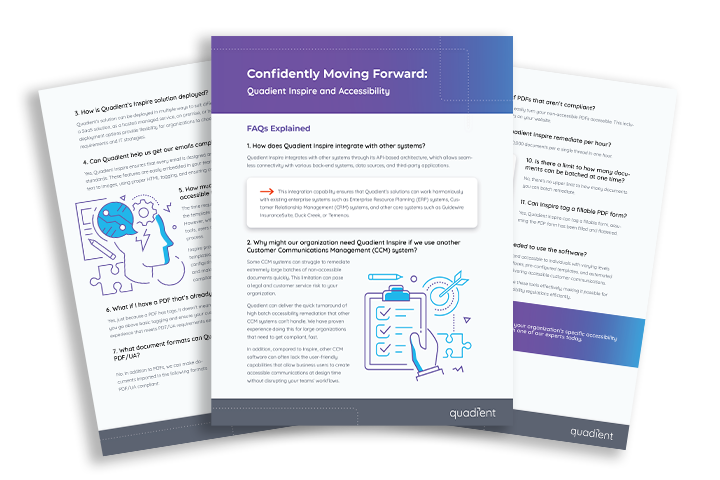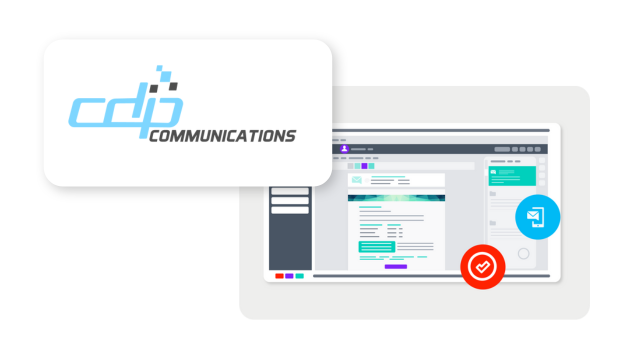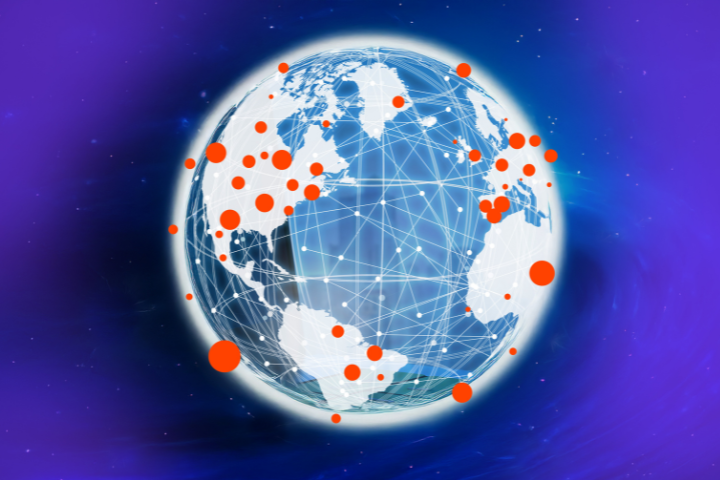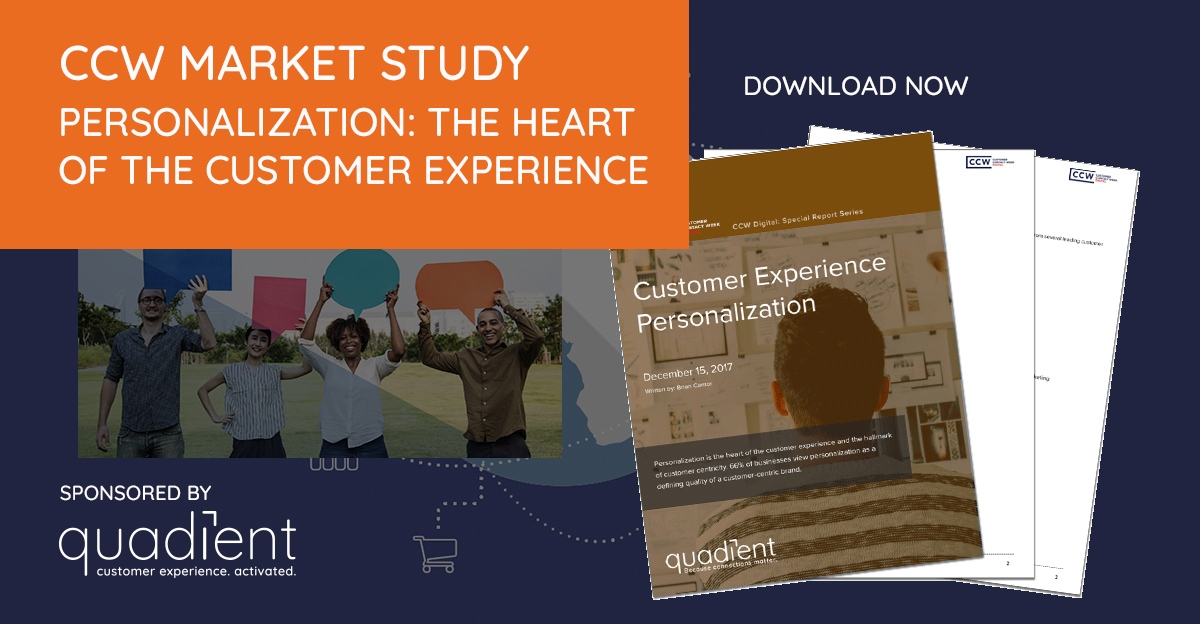
What is CX?
Every day at Quadient, we get a lot of questions regarding customer experience - what it is, and how to harness the power of customer communication management, customer journey mapping and business user empowerment to create exceptional customer experiences. Let's look at some of the most pertinent questions surrounding the topic today.
To define customer experience, let’s take a step back and explain why it’s so important for companies to focus on the customer.
Gartner defines customer experience as:
"the discipline of understanding customers and deploying strategic plans that enable crossfunctional efforts and customer-centric culture to improve satisfaction, loyalty and advocacy."
While Harley Manning, VP, Research Director of Forrester defines CX as:
"How customers perceive their interactions with your company."
In its simplest definition, customer experience is (a) the sum of all the interactions that a customer has with a company over the course of the relationship and includes (b) the customer’s feelings, emotions, and perceptions of the brand during the course of those interactions. Examples of “interactions” include: making a purchase, using a product, viewing statements, reading correspondence, calling support, visiting the company’s website, receiving an email from the company, receiving notifications via mobile app, and more. Focusing on the customer experience results in increased customer satisfaction and retention, stronger revenues and profitability, reduced costs (of servicing and of acquiring), as well as growth through word of mouth/referrals, repurchases, and expansion among existing customers to the brand’s other products and services.
The CXPA defines CX as "the perception that customers have of an organization - one that is formed based on interactions across all touchpoints, people, and technology over time.". Learn more about customer exprience nomenclature by visiting the CXPA knowledgehub.
What is customer experience (CX) strategy?
When it comes to the CX strategy, customer communications are often one of the most overlooked—yet critical—components of the customer journey. In many cases, the CX strategy tends to focus on frontline communications—training and coaching employees regularly on how to best speak (and interact) with customers. Yet, customer communications such as contracts, customer correspondence, customized quotes, welcome kits, invoices, and statements, are equally important to the overall customer experience and represent a significant percentage of overall customer touchpoints.
With these communications, rarely does the customer voice and the customer’s experience get incorporated into design and delivery. These documents perpetuate inside-out thinking, where the company knows best, rather than outside-in thinking, where the customer is a part of every design and decision. Invoices, statements, and other necessary customer communications aren’t going away. They are fundamental essentials of the business.
The following video demonstrates how CX Strategy can be applied in the insurance industry:
Why focus on CX?
Consumers today have more choice in their purchasing decisions than ever before. With increased access to online price information and reviews, and informal public opinion on social media, many businesses have recognized that building a better customer experience is essential for sustaining competitive differentiation. In highly regulated B2C industries, such as financial services, insurance, utilities, and telecoms, this is often achieved by focusing on creating cross-channel communications. By providing deeply personalized and seamless experiences across the customers’ channels of choice, businesses build more loyalty and increase retention.
What is the CX customer lifecycle?
The customer lifecycle is often depicted as follows, as a continuous loop, with hopes that customers not only buy and own but also to become a brand advocate and buy again. The Buy phase is when customers realize a need, become aware of brands that can meet the need, research the brands and their products, select a brand, and then ultimately make a purchase. During the Own phase, customers use the product, get service and support, and recommend the brand and its products to friends and family. Rightly so, brands spend a lot of time, effort, and money ensuring that first impressions are strong – strong enough to encourage customers to buy.
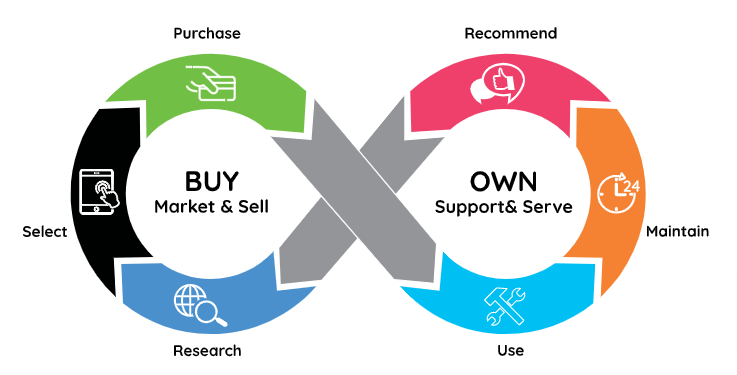
Acquiring new customers is important to any business. But, as mentioned earlier, there is a disproportionate amount of effort placed on the early stages of the lifecycle, on efforts to attract and to convert the potential customer, that the lifecycle becomes lopsided, i.e., once the customer is on board, after the customer has made that first purchase, it’s all over; brands make little or no effort to keep the customer engaged by failing to deliver a great experience through any post-purchase interactions. As a result, customers become frustrated with the brand and refuse to buy again; and brands get stuck in an unending cycle of acquire, churn, acquire, churn, acquire, churn, etc.
This is a major challenge for customer experience professionals, since they look at the experience more holistically, i.e., from before the customer is even a customer through the end of the customer relationship with the brand, ensuring that the experience is worthy of that first customer purchase but consistent throughout the relationship and worthy of ongoing repeat purchases.
Consistency of the experience is key throughout the lifecycle – but especially as the customer moves from the Buy phase to Own. That “handoff” cannot be lost; just because the sale is won doesn’t mean the work to develop and to maintain a relationship stops.
What is CX personalization?
When it comes to customer experience, personalization is the idea of tailoring a customer experience to the individual interests, behaviors, needs and preferences of customers.
There are various degrees of personalization. There, moreover, are numerous ways in which organizations incorporate personalization into their experiences. Some organizations outright oppose the idea. Others pay lip service to the notion but do not truly immerse themselves in the practice.
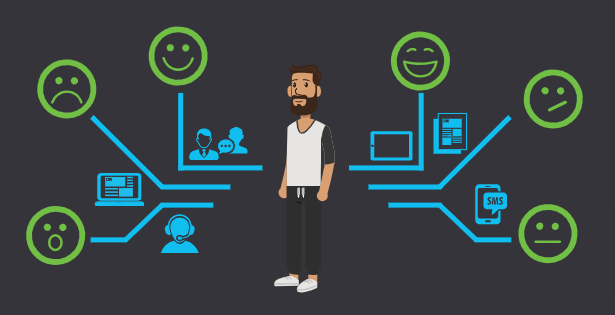
In formulating a customer experience strategy, it is important to explore the full
“personalization spectrum.” Not simply a snapshot of the various ways in which organizations are tailoring experiences, the spectrum reveals how personalization factors into the overarching customer experience mission.
For a deeper dive into personalization, you may wish to download this complimentary market report.
The spectrum illustrates how personalization can assist with goals like reducing customer
effort, shrinking inbound call volume, increasing revenue and building lasting customer relationships.fully committed to personalization. While one contingent commits wholeheartedly to the idea of meaningfully connecting with customers, another primarily leverages personalization to make interactions more productive.
In formulating a customer experience strategy, it is important to explore the full “personalization spectrum.” Not simply a snapshot of the various ways in which organizations are tailoring experiences, the spectrum reveals how personalization factors into the overarching customer experience mission.
The spectrum illustrates how personalization can assist with goals like reducing customer
effort, shrinking inbound call volume, increasing revenue and building lasting customer relationships. The steps of the CX personalization spectrum are:
• Impositional experience
• Passive personalization
• Polite personalization
• Productive personalization
• Predictive personalization
• Poignant personalization
What is an impositional experience?
Personalization may be a widespread priority in theory, but not all organizations are taking
action. Some opt not to deliver personalized experiences. Rather than taking into account specific customer needs, these organizations simply offer a finite number of engagement options and adhere to a strict, static, scripted set of processes. Customers can either accept what the organization is offering – or take their business elsewhere. The “impositional” approach may involve viewing the CX strictly in terms of “inbound customer service.” There is no effort to optimize the overall journey.
What is passive personalization?
Instead of actively tailoring experiences to specific customers, the passive approach
involves providing enough options and flexibility to accommodate most customer
preferences. Customers will often have access to the core experience they desire
(and thus sense some “personalization”) even though the brand did not consciously
consider their individual needs.
What is polite personalization?
In an effort to prove that they view customers as people rather than as numbers, some
organizations offer a “polite” degree of personalization. Leveraging information from
CRM systems, agents will greet customers by name. They may also reference material facts
about the customer in inbound and outbound communication. Polite personalization is about
demonstrating superficial recognition of the customer. It does not involve customizing the
actual engagement experience.
What is productive personalization?
For some organizations, personalization involves more than recognizing customers. It involves using information about a specific customer to actually optimize the experience. This “productive” form of personalization is not about engaging in deep conversations or making friends; it is about using contextual knowledge to reduce customer effort (particularly repetition of information), route customers to the right agent or resource and provide the fastest, yet most valuable resolution possible. By understanding who the customer is and why the customer is likely interacting, the business can deliver an optimal response.
What is predictive personalization?
Productive personalization will often involve an “anticipatory” element, but it is ultimately
about improving a single interaction. Some businesses go beyond the interaction – and optimize the overall journey. These organizations leverage a “predictive” form of personalization. Using existing data about the customer’s purchases, personality, preferences and support history, they predict – and cater experiences to – a customer’s future needs and behaviors.
What is poignant personalization?
Some customer management thought leaders urge businesses to go beyond “support” and
engage in deep, meaningful conversations with customers. These thought leaders are
advocating for poignant personalization. Rather than optimizing the purchasing process
or support experience, poignant personalization involves building human “connections” with customers. Agents will ask questions to get to know customers as people with backstories, interests and hobbies.
Why is CX personalisation important?
In a broader customer experience context, personalization helps optimize every facet
of the journey. It is about anticipating why a customer may contact and being armed with the most valuable possible resolution. It is about predicting what a customer will want next and delivering it before they even ask. It is about determining where a customer prefers to engage and eliminating barriers to engaging in that channel. It is about respecting and understanding the language a customer uses and communicating in corresponding terms.
Extending existing relationships is famously more economical than developing new
ones. By leveraging personalization for retention, organizations will receive a
greater “bang for their buck.” The cost of an ineffective experience journey is, moreover, more significant than that of an impersonal marketing message.
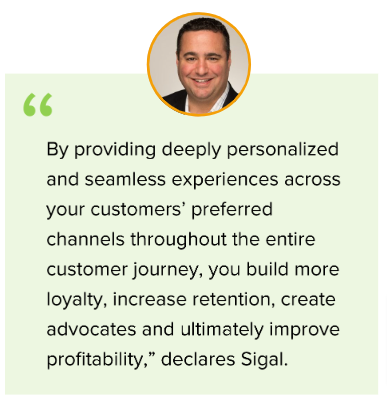
If a company errs in its marketing message, it simply fails to attract a potential customer’s
interest. It can always attempt to court that customer at a later date. If a company errs in a later phase of the customer experience, however, it risks losing an existing customer and the future revenue on which it was banking. The stakes of the customer experience heighten as the journey progresses, which means the importance of personalization increases after the initial point of purchase.
When creating a CX strategy, should I focus on new customer acquisition, or retention?
Companies have been pouring disproportionate resources – human, time, effort, capital – into the top of the funnel, on attracting and acquiring new customers, while retention efforts have gotten little more than loyalty programs and discount offers. The answer to the dilemma of focusing on the Buy stages of the lifecycle versus the Own stages can easily be summarized by a series of statistics that convey a very strong point: retention trumps acquisition, both for the business and for the customer.
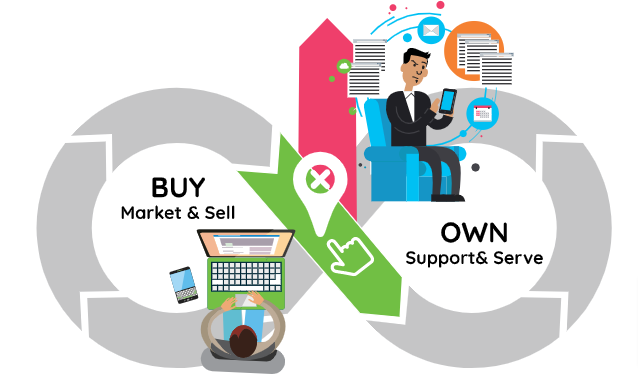
- A 5% reduction in the customer defection rate can increase profits by 25-95%. -Bain & Co/HBR
- A 2% increase in customer retention has the same effect as decreasing costs by 10%. -Emmet and Mark Murphy
- The probability of selling to an existing customer is 60-70%. The probability of selling to a new prospect is 5-20%. -Marketing Metrics
- Customer profitability tends to increase over the life of a retained customer. -Emmet and Mark Murphy
- 55% of current marketing budget is spent is on new customer acquisition and only 12% on customer retention. -McKinsey
- It is 6 to 7 times more expensive to acquire new customers than it is to keep a current one. -White House Office of Consumer Affairs
- A 10% increase in customer retention levels result in a 30% increase in the value of the company. -Bain & Co
- Most important marketing objectives? 29.9% think it should be customer acquisition, and 26.6% think it is customer retention; however, 62.2% admit that they concentrate on customer acquisition, with only 20.6% focusing on customer retention. –eMarketer
- 80% of your future profits will come from just 20% of your existing customers. -Gartner
- A 10% increase in customer retention yields a 30% increase in the value of the company. -Bain & Co• Repeat customers spend 33% more compared to new customers. -Laura Lake
How do I invest in a CXM platform?
Today, customer preference demands, and a constantly changing communications landscape, are driving enterprises to rethink how they manage customer communications. The more customers, communication channels, products, and services an organization has, the more likelihood there are many systems—both legacy and modern—in place to manage it all. The result is an infrastructure of software, hardware, and business rules that requires a lot of care. In most cases, the management of customer communications lacks a holistic strategy.
Enterprises that invest in a centralized end-to-end CXM platform to design, manage, and deliver cross-channel customer communications are able to realize the following benefits:
• Increased operational efficiency
• Streamlined processes and elimination of organizational and digital silos
• Consistency in brand image and messaging
• Reduced risk
• Cost savings
• Improved time-to-market
• Enabling next-gen communications
• Improved CX
• Customer journey orchestrationi
However, it’s important to note that technology migration is sometimes a complex undertaking. Therefore, selecting a CCM provider who has a proven methodology and extensive migration experience is critical.
Check out this video for more information on how to make the transition from customer communications management to CX.
Quadient Inspire is the industry's leading CXM platform - offering cloud and on-premise options to help enable your business users to create and deliver powerful communications, interactions and experience across multiple channels. Learn more here.
How do I manage communications as part of a CX strategy?
Outbound customer communications are often one of the most overlooked details of a journey mapping exercise despite the fact that 85% of firms believe that seamless experiences are critically important or very important to their overall CX strategy and business goals.
When it comes to CX, companies tend to focus on frontline communications, training and coaching employees regularly on how to best speak—and interact—with customers. Your customer communications are equally important. They must be streamlined, consistent, clear, and relevant wherever they’re delivered along the journey.
It’s critical to capture these communications in your journey maps as they are often a key moment of truth for your customers. For example, if there are miscommunications, e.g., “I couldn’t make sense of my bill,” then the experience is negatively impacted. And that impacts you in the form of increased call volume and decreased customer satisfaction, potentially increasing customer churn. Customer journey mapping helps ensure that you’re aware of where and how to best deliver these communications and to ensure that they not only meet the needs of the customer but also remain consistent with the brand promise.
Investing in new CXM technology is no small task, but success is achieved with the proper planning and support early on. Acquiring the support of influential leadership is a key step in ensuring success. A thorough needs assessment that will feed a requirements document is also critical to finding a solution that meets current and future needs. And finally, enterprises must perform a rigorous evaluation and selection process to find the right solution. Achieving a successful CXM infrastructure does not end with finding the right solution. Consideration, support, and dedication to the implementation and migration of applications to the new system is essential for long-term success.




